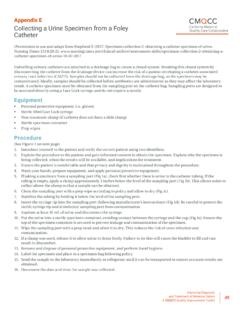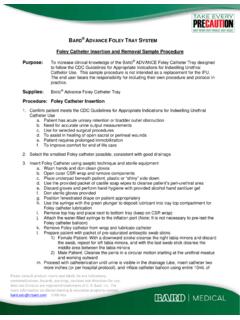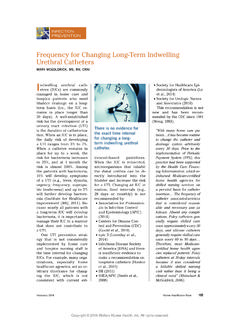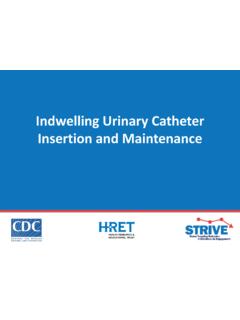Transcription of Insertion of an Indwelling Urethral Catheter in the Adult …
1 86 UROLOGIC NURSING / March-April 2021 / Volume 41 Number 2 ClInICAl PRACTICe PRoCeduReInsertion of an Indwelling Urethral Catheter in the Adult MaleIntroduction This procedure details the Insertion process of an Indwelling Urethral (transurethral) Catheter (IUC or foley Catheter ) in an Adult male. The male urethra length is inches (20 cm) and is curved (referred to as an S curve) as it descends in its last 4 to 5 cm proximally through the urogenital diaphragm and prostate (Figure 1). Male Urethral Catheter placement can be difficult because of the length and curves of the male urethra and the skill of the person perform-ing Insertion . This procedure uses an aseptic technique that is maintained throughout the Insertion and based on professional guidelines. Only health care profession-als trained in the technique of aseptic catheterization should insert an IUC. Persons attempting trans - Urethral catheterization should be familiar with the facility or practice policy and standard precautions for Urethral catheterization.
2 Prior to Insertion or replacement of an existing IUC, an order from a health care provider should be verified. The patient and the patient s family, if pres-ent, should be informed of the reason for catheteriza-tion and what to expect in terms of discomfort. If the patient is unable to give consent and there is no fam-ily member or guardian to provide consent, there must be a clear rationale for using a Catheter . Indwelling urinary Catheter (IUC) use indica-tions and contraindications in Adult males are found in Box 1. Risk Assessment Determine any potential allergies ( , latex, betadine). Note any pertinent past medical and urologic history, including Urethral stricture or scarring, benign prostatic hyperplasia (BPH), Urethral implants, prior bladder, prostate. ure-thral or pelvic surgery, or radiation. If the patient has an artificial urinary sphinc-ter implant, a consult to urology may be nec-essary if the nurse is not familiar with this implant because the device s cuff must be deflated before Insertion .
3 If there is a history of difficult Urethral Catheter -izations, consider the use of a guidewire (called a glidewire or Hiwire) with a hydrophilic coat-ing. Hydrophilic-coated smooth surface guide -wires have a very soft end, making it safe to pass through a stricture or distorted urethra with min-imal risk of injury. Stiff guidewires should not be used. A Council tip (16 Fr gauge with an open end) Catheter with a self-retaining balloon or reg-ular IUC created as a Council tip can be inserted over the stiff outer end of the guidewire (Figure 2). The Catheter is advanced over the guidewire via the urethra and into the bladder. Task Force Chair Diane K. Newman, DNP, ANP-BC, FAAN, BCB-PMD Task Force Contributors Susanne A. Quallich, PhD, ANP-BC, NPC, CUNP, FAUNA, FAANP Margaret A. Hull, DNP, WHNP-BC Gina Powley, MSN, ANP-BC Katie Wall, MSN, FNP-C Peer Review Urologic Nursing and the Society of Urologic Nurses and Associates appreciate the assistance of the individuals listed below who contributed to this project by providing com-ments and direction during the peer review process.
4 Their reviews do not necessarily imply endorsement of these documents. Laura R. Flagg, DNP, ANP-BC, CUNP David Martin Julien, DNP, FNP-C, CUNP Michelle J. Lajiness, MSN, FNP-BC, FAUNA Donna L. Thompson, MSN, CRNP, FNP-BC, CCCN-APFigure 1. Male Indwelling Urinary CatheterSource: Courtesy of Diane K. Newman, NURSING / March-April 2021 / Volume 41 Number 287 Consider obtaining assistance ( , two-person Insertion ) to facilitate appropriate visualization for high-risk populations ( , patients who are obese or comorbid, or with dementia/behavioral issues). Challenging aspects of male Urethral catheterization can be accessing the meatal orifice, especially in an obese man with a large girth or those with an enlarged prostate that may obstruct the urethra. Assess the patient s ability to cooperate with procedure ( , need to keep legs straight and relaxed during procedure). Assess level of anxi-ety about Catheter Insertion , and if present, pro-vide information about the procedure and meth-ods that will be used to minimize discomfort ( , analgesic gel).
5 Prior to starting the procedure, assess the penis. If penile edema or a buried penis is present, Indications Postoperative urinary retention (per facility Catheter -removal policy). Bladder outlet obstruction ( , gross hematuria, benign prostatic hyperplasia [BPH], Urethral strictures). Acute urinary retention, which requires immediate attention. Need for accurate measurements of urinary output in critically ill patients for which urine cannot be measured in another way. Patients who require prolonged immobilization ( , potentially unstable thoracic, or lumbar spine, multiple traumatic injuries, such as pelvic fractures). Continuous bladder irrigation (CBI) for clot retention or intravesical drug infusion. Administration of drugs directly into the bladder ( , chemotherapeutic medication to treat bladder cancer). To improve comfort for end-of-life care, if needed Perioperative use in selected surgical procedures: Urologic/gynecologic/perineal procedure and other surgeries on contiguous structures of GU tract.
6 Anticipated prolonged duration of surgery (should be removed in PACU once patient is awake). Patients anticipated to receive large volume infusions or diuretics during surgery. Operative patients with urinary incontinence. Need for intra-operative hemodynamic monitoring of fluids. Contraindications For perceived comfort in patients with urinary or fecal incontinence. As a means for obtaining urine for tests when patient can voluntarily void. Prolonged postoperative use without appropriate indications. Box 1. Indications and Contraindications for Use of an Indwelling Urinary Catheter (IUC) in Adult Menexpose a buried penis by having an assistant press down firmly around the base of the penis or use a small vaginal speculum through the swollen foreskin to allow visualization of mea-tus. According to the National Institute for Health and Care Excellence (NICE) ( ), routine pre-scribing of antibiotics is not recommended when inserting an IUC or changing a Catheter in pa -tients with a long-term IUC and antibiotic pro-phylaxis is only recommended in those patients who have a history of symptomatic urinary tract infection (UTI) after Catheter change or experi-ence trauma during catheterization.
7 Equipment Assemble all equipment before beginning proce-dure. Lighting as needed. Perineal care items: Disposable clean gloves, mild soap, chlorhexidine gluconate (CHG) soap, water, and/or cleansing foam. Castile soap is the recommended alternative for cleansing patients with a betadine aller-gy. Closed Catheter system contain supplies ( , gloves, cleanser) for periurethral cleans ing (Figure 3). Waterproof pad. Indwelling Catheter Insertion tray ( , all-in-one catheterization kit with a closed or pre-con-nected, sealed Catheter -tubing junction system preferred) includes sterile gloves, single-use Figure 2. Council Tip Next to Straight Catheter TipSource: Courtesy of Eric Rovner, of an Indwelling Urethral Catheter in the Adult Male88 UROLOGIC NURSING / March-April 2021 / Volume 41 Number 2water-based lubricant (tray may include a pre-filled syringe), indwel -ling balloon-retention Catheter (use smallest size [gauge] possible that allows free flow of urine unless oth-erwise prescribed, standard is 14 Fr), Luer-Lok syringe pre-filled with ster-ile water (standard balloon size is 10 ccs, always inflated with 10 ccs of sterile water to ensure a symmetrical shape), an choring de vice for securing Catheter , and pre-connected urinary drainage bag.
8 The balloon port has a cover that notes the size of the Catheter and balloon size (Figure 4). Sealed or closed sterile systems have a pre-connected, tamper-resistant tape or seal that keeps the Catheter and drainage system connected (Figure 5). It is de -signed to prevent inadvertent opening of the closed drainage system and may prevent Catheter -associated urinary tract infec-tions (CAUTIs) by acting as a physical barrier to the migration of microbes into the lumen of the Catheter and drainage tube. There are potential disadvantage of these systems because only the prepackaged Catheter can be inserted. Figure 3. Indwelling Urinary Catheter Tray System with Perineal Cleansing Supplies (SureStep foley Tray Peri-Care Kit by Bard Medical)Figure 4. Balloon Port Noting Catheter Size (16 Fr) and Balloon Size (10 cc) Figure 5. SureStep Indwelling Urinary Catheter Tray by Bard MedicalPhoto: Courtesy of Diane K.
9 Newman, : Courtesy of Diane K. Newman, : Courtesy of Diane K. Newman, Practice ProcedureUROLOGIC NURSING / March-April 2021 / Volume 41 Number 289 Consider having a second Insertion tray easily available in case of contamina-tion during sterile Insertion . If all-inclusive Insertion tray is not available, alternative sterile equipment can be used, but all parts must be sterile ( , gloves, single-use sterile water-based lubricant packet, Catheter , syringe filled with 10 cc sterile water, drainage bag/valve, securement device). Only sterile water should be used to inflate the balloon because saline may crystallize in the balloon port, obstructing it, prevent-ing balloon deflation at time of IUC removal. If patient has an allergy to latex, use a 100% silicone Catheter . If a history of previous difficult catheterization and/or an enlarged prostate, the clinician should use a Catheter with a Coud (curved Tiemann type) tip (Figure 6) that allows for eas-ier passage through the prostate.
10 The angled Catheter tip should point cephalad (toward the head, 12 o clock position) during the Insertion (Figure 7). This will allow for smoother passage through an enlarged prostate and is the most important component to ensure correct position of the urethra while passing the Catheter . Always inform the patient of the use of a Coud -tip Catheter , which may make the catheteriza-tion less painful, thus relieving fear of Catheter -ization. The use of an anesthetic gel (lidocaine gel 2%) inserted in the urethra prior to catheterization is an option in male catheterization and should be considered if this is the patient s first catheteri-zation or if a difficult catheterization is suspect-ed, especially if actual discomfort with Catheter Insertion is anticipated. The main benefit may be from the lubrication as opposed to the anes-thetic effect (Averch et al., 2014). It may reduce pain, promote pelvic muscle/sphincter relax-ation to add Insertion , and/or it may help to dis-tend ( open ) the Urethral lumen when the lubricant is held in the urethra using mild com-pression at the fossa navicularis (just below the glans penis).








